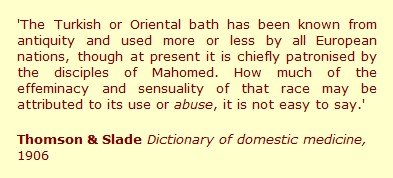7. Charges of indolence and effeminacy

The leisured class saw further reasons to deny the benefits of the Turkish bath to those whose work supported them in the manner to which they were accustomed.

It led, they claimed to indolence and would destroy the manliness which created the British Empire, as it had destroyed the Roman Empire, and as it was then destroying the Ottoman Empire.26
 Such attitudes inevitably led to xenophobia and what we should now call racism. On 28 January 1861, Dr J L W Thudichum read a paper on the bath to the Medical Society in London27 which aroused much correspondence in the medical journals. On 2 March, Dr Thomas Garlike wrote, in a letter to the editor of
The Lancet:
Such attitudes inevitably led to xenophobia and what we should now call racism. On 28 January 1861, Dr J L W Thudichum read a paper on the bath to the Medical Society in London27 which aroused much correspondence in the medical journals. On 2 March, Dr Thomas Garlike wrote, in a letter to the editor of
The Lancet:
Can the active, fox-hunting, cricketing, boating Englishman bear the same kind of treatment that benefits and gratifies the indolent, languid, luxurious Turk?28
While an editorial in the same week’s British Medical Journal stated that:
The [Turkish bath] may be adapted to the mental and physical constitution of those lazy Eastern voluptuaries, who have cost us so much trouble and so many lives, and the well-fed and fatted contents of their harems. The slothful pasha may work off his superfluous hydrocarbons and nitrogenous materials through the sudoriferous ducts and the pulmonary mucous membrane; but healthy men of business and of sense in this country will, we venture to prophesy, never consent to the dissipation of time and matter involved in the idea of a periodical Turkish bath.29
Loss of manliness and effeminacy were frequently ascribed to the regular bather, arguments which were contradicted (but ever so warily) by Dr Henry W Kiallmark:
Except in the case of those who take the bath for a specific purpose, I think its use should not be regarded as an affair of daily recurrence. It must never interfere with, or take the place of, the Englishman's daily ‘tub’; and, with this proviso, the alarm expressed by some, that it will lead to effeminacy and degeneracy of race, as it is said to have done with the ancient Romans and the modern Turks, may be looked upon as fallacious.30

